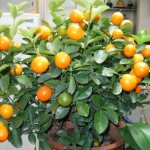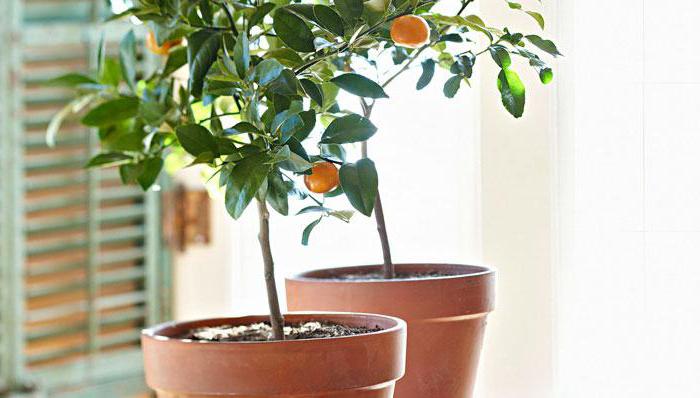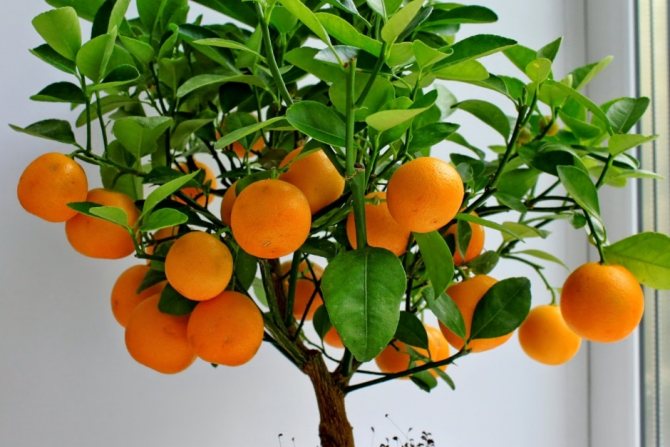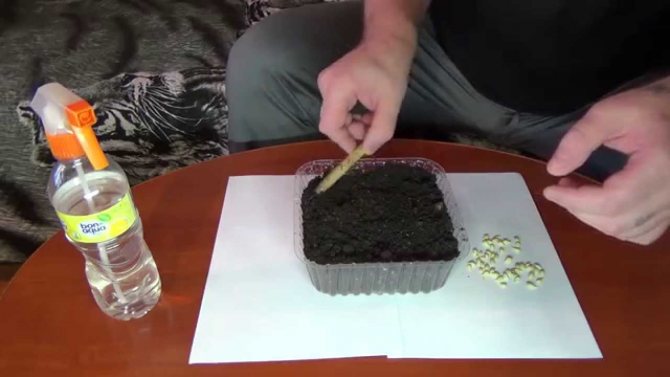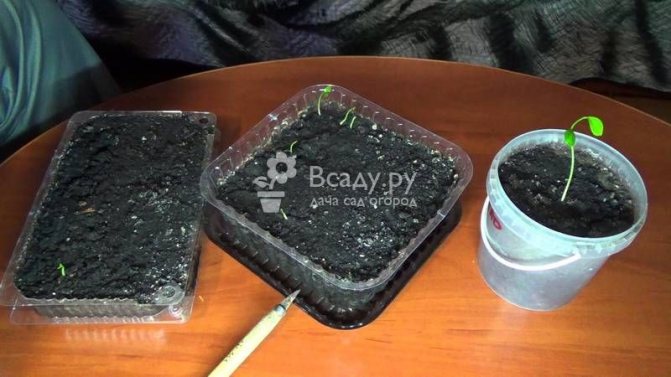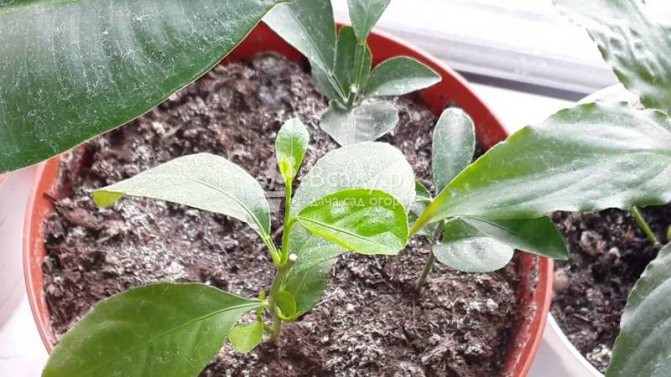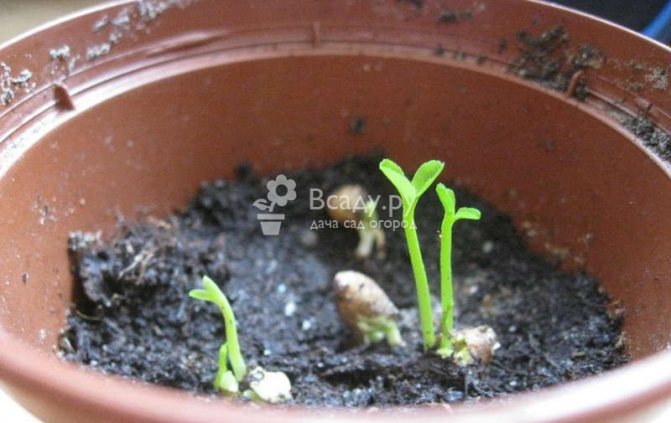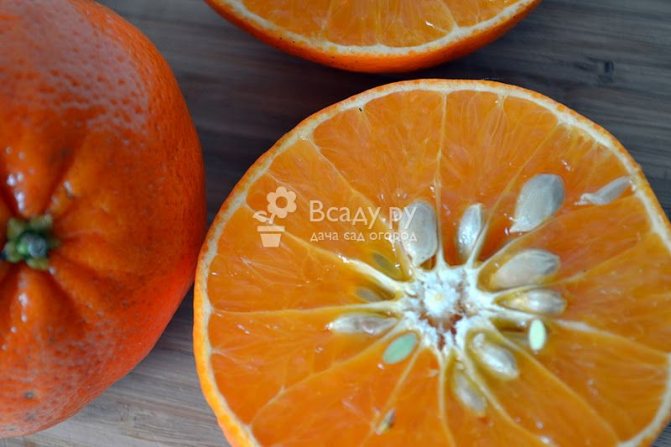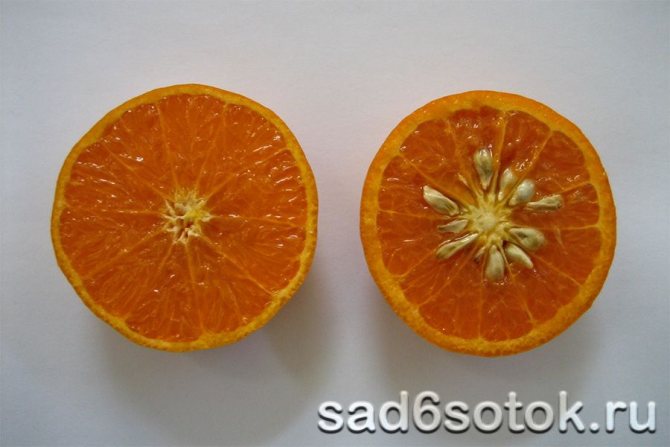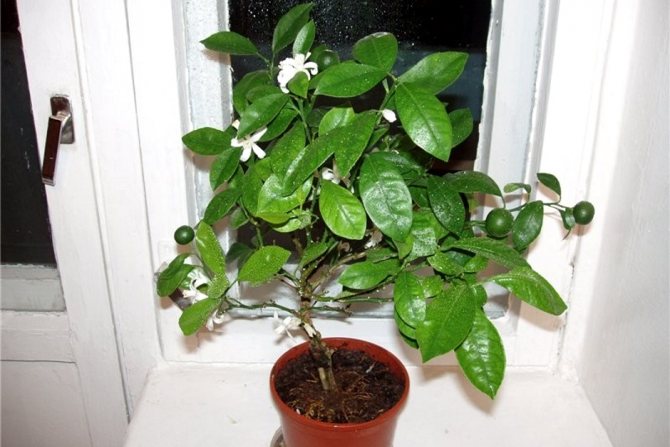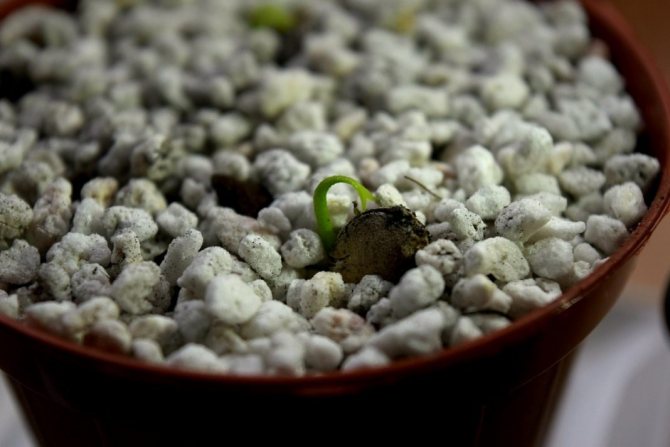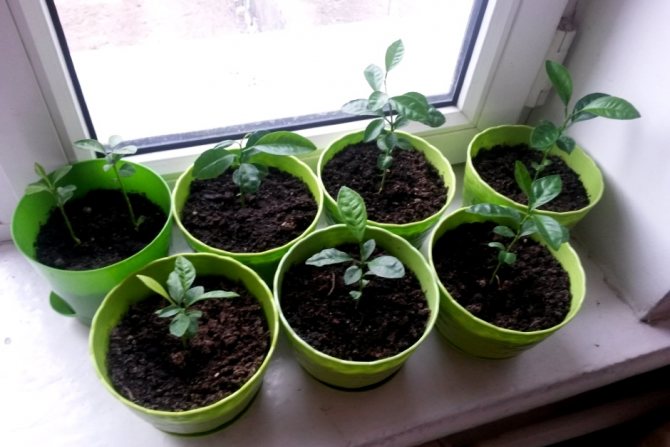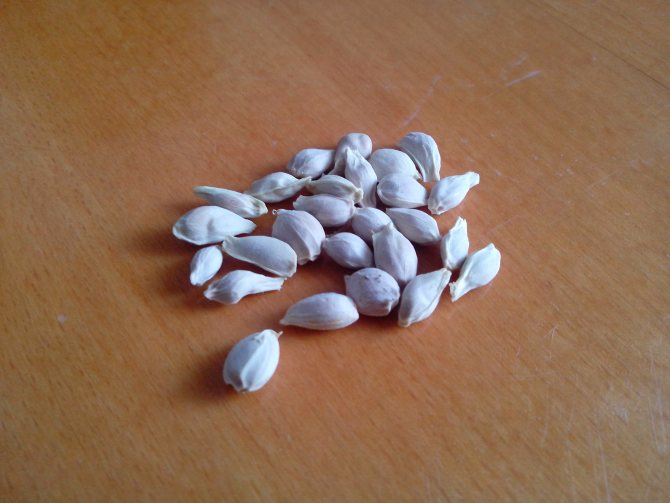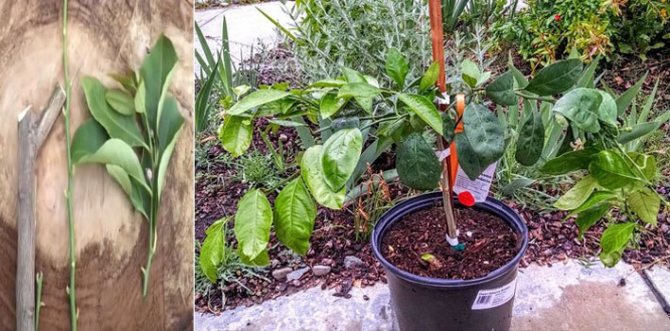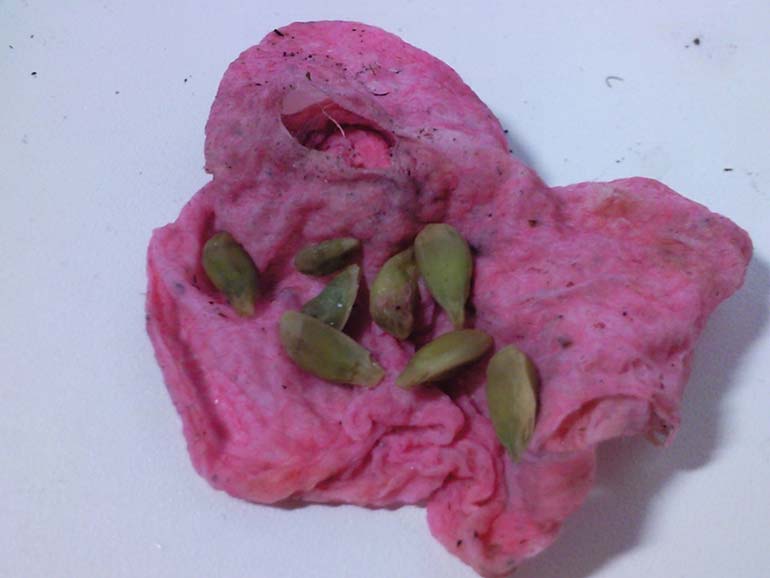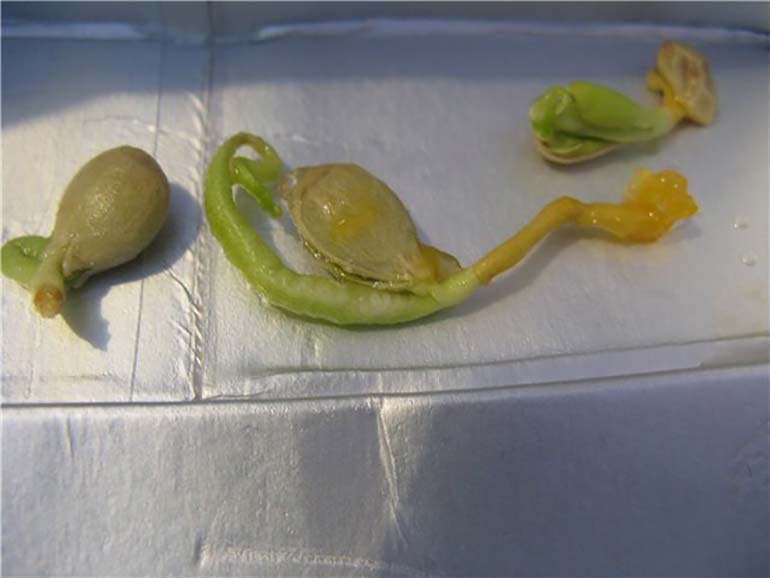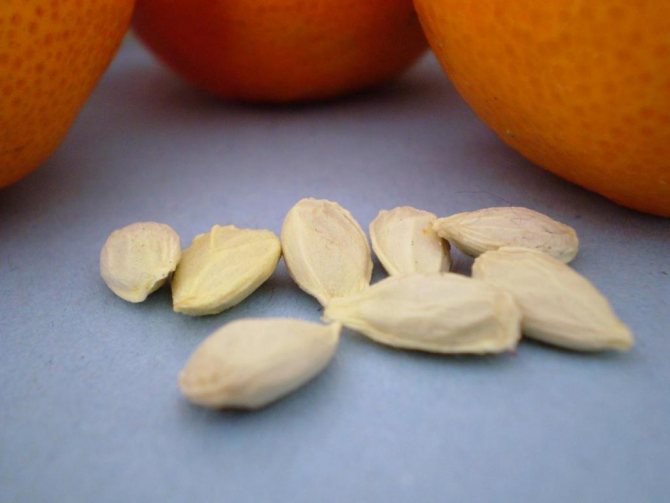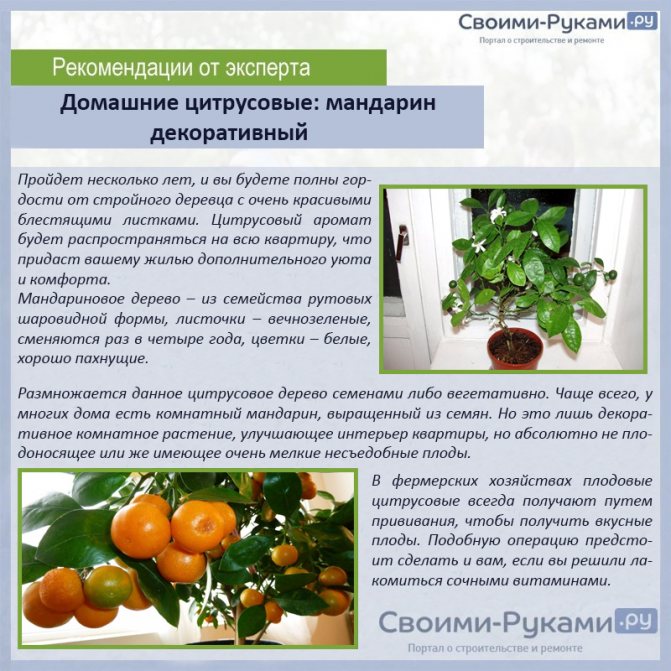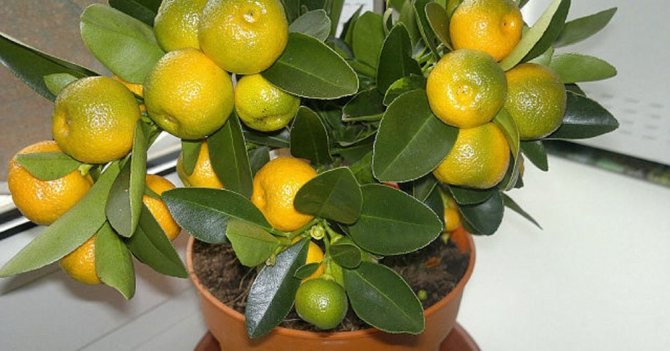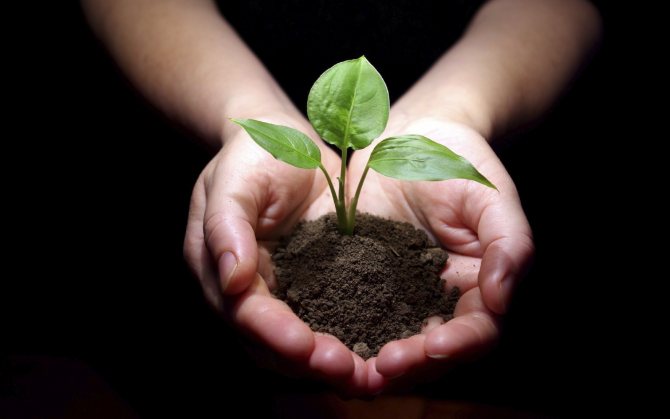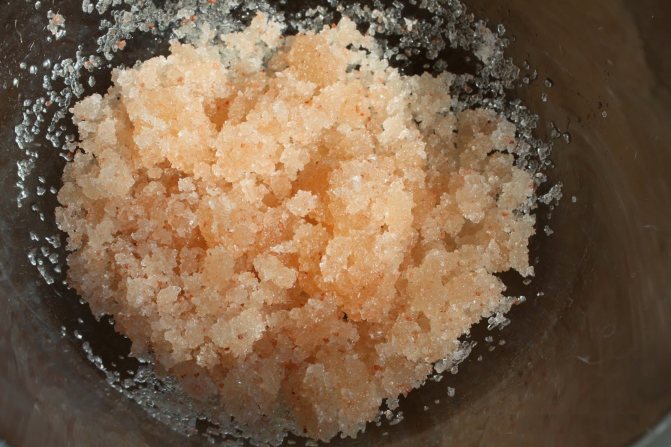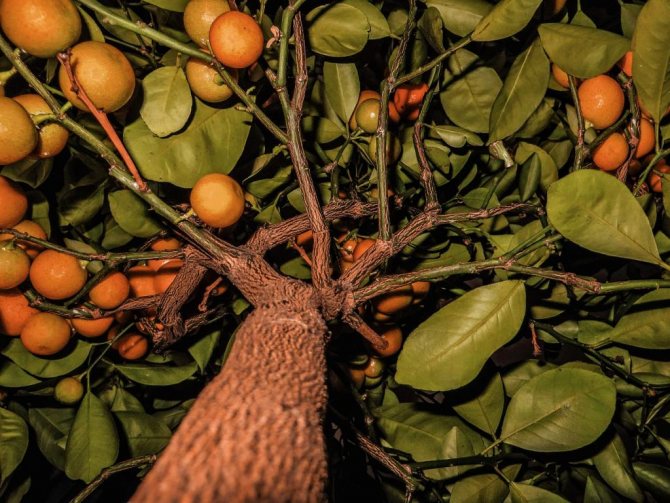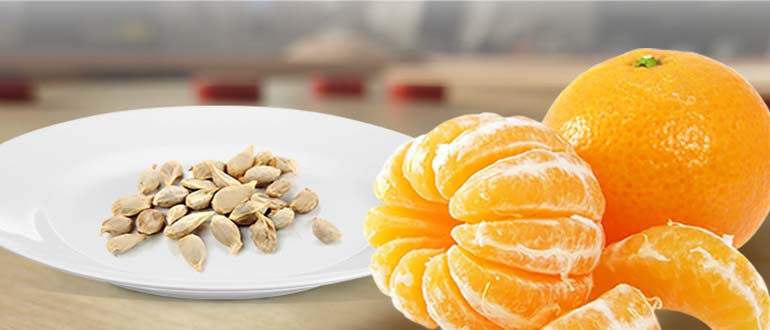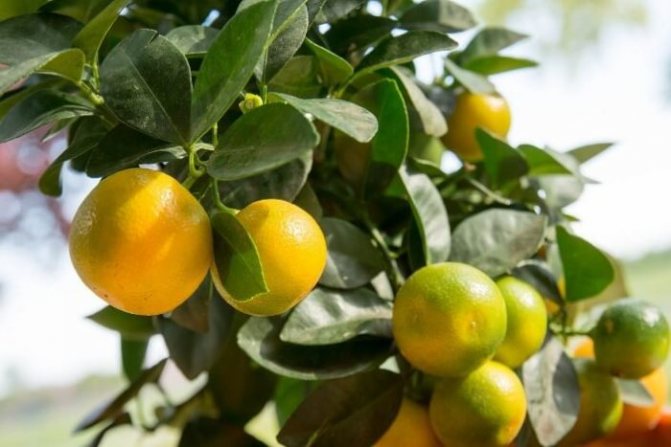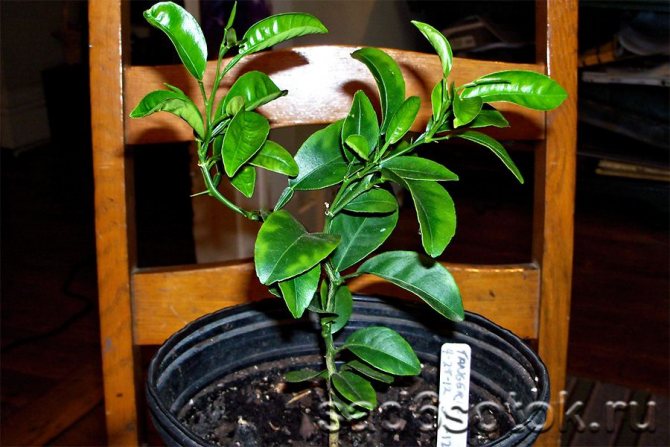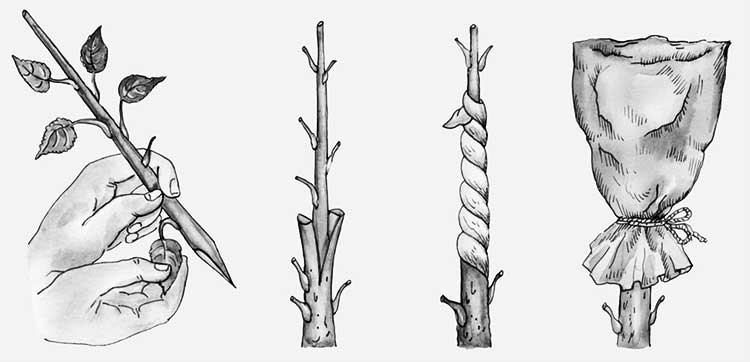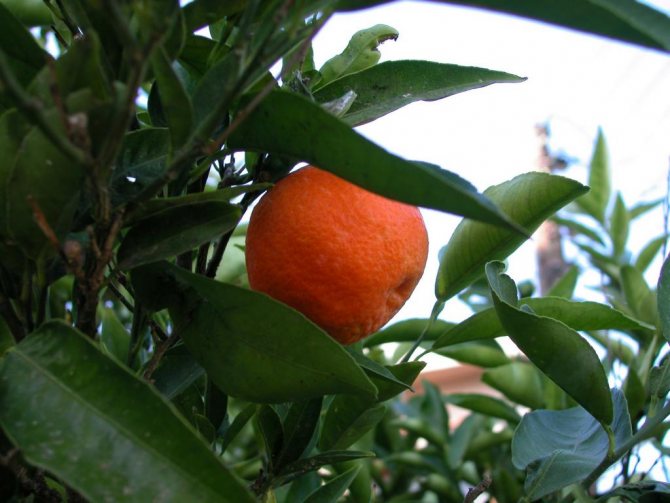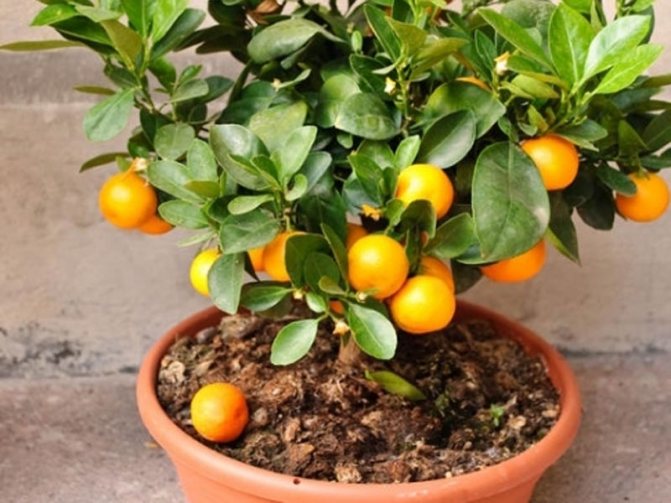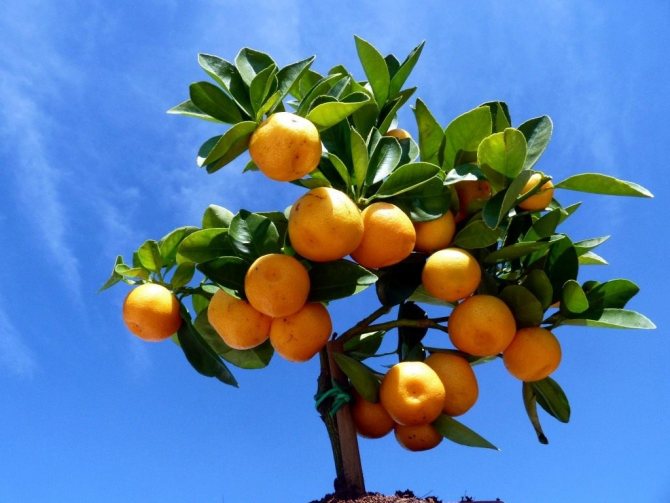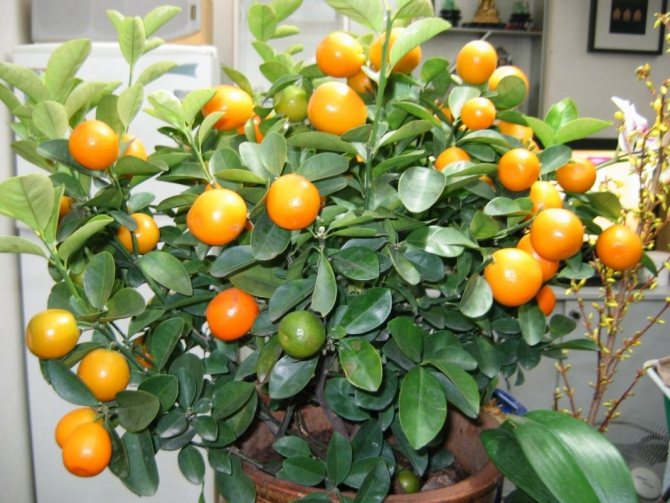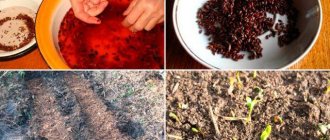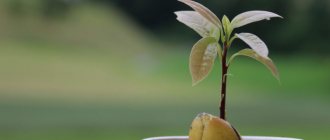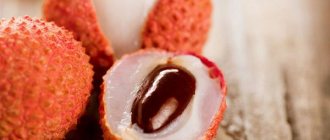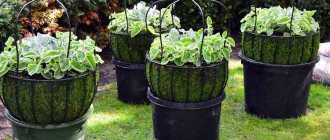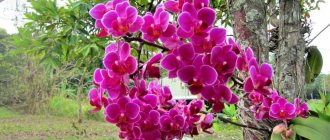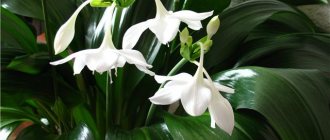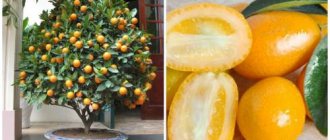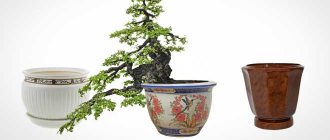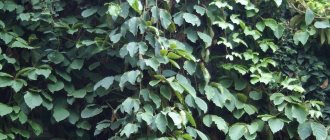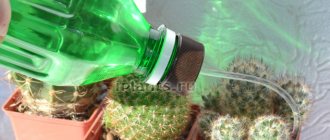Every self-respecting florist tries to grow an unusual homemade exotic plant on his own, starting with planting a seed. Tropical tangerine is no exception, which is increasingly found on the shelves of flower shops. Knowing the growing conditions, it is not so difficult to get a tangerine from a seed. It will take about 5 years, and the florist will rejoice at the homemade exotic tree with bright balls of fruit. Let's try to figure out how to care for a tangerine tree so that it looks decorative and brings a small harvest.
Is it possible to grow a tangerine from a bone at home
Mandarin is an exotic citrus plant that is a short evergreen tree. In its natural environment, it grows in the southern latitudes: in China, Morocco, Japan and South Korea. In these countries, mandarin is the same common fruit plant as apple trees are for us.
Mandarins love a mild climate. And similar conditions can be recreated in an apartment. Therefore, tangerine seeds can be planted in flower pots: citrus trees will grow from them, and over time they will even begin to bloom. True, it will be in 9-10 years. And the fruits will be small and tasteless. But this can be fixed. First, we will tell you how to properly plant a tangerine seed so that a healthy plant grows from it.
When to plant tangerines
The optimal planting time is January-February. Reason: it will take about 30 days for germination, and after it the sprouts adapt for about two weeks and only then active growth begins. That is, the tangerines will be ready to develop by the end of March, just at this time daylight hours allow them to do this in the best conditions. But this parameter is not the most fundamental, if you want to plant the bone at some other time, then this can be done. In the latter case, the only drawback is not the fastest growth.
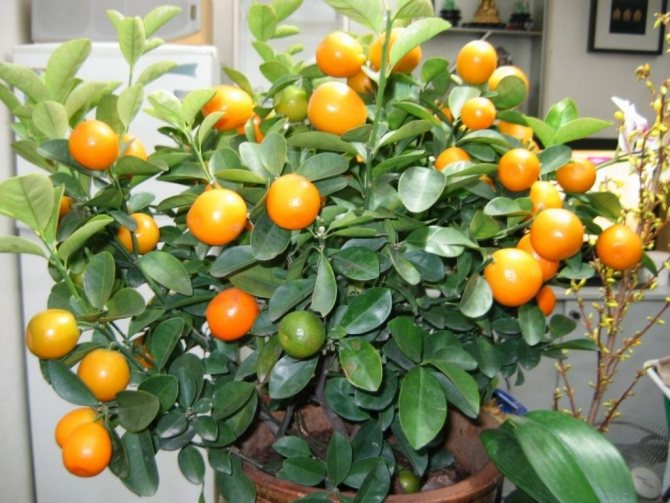
Preparation of planting material
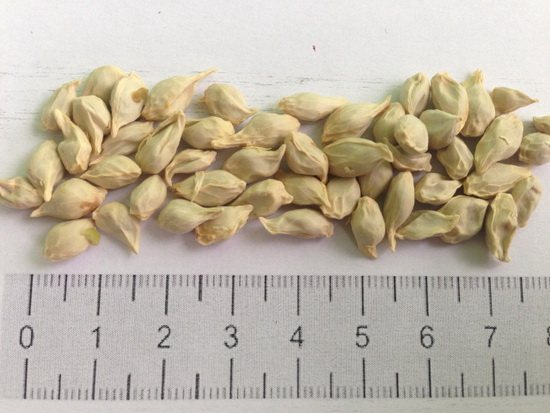

Tangerine seeds can be obtained from regular store-bought tangerines. For planting, you need to choose the largest ones: they will grow strong seedlings with a well-developed root system. Small ones may not germinate at all. Another important condition is that the seeds must be taken fresh, just removed from the fruits. If they have time to dry, you will wait a long time for seedlings from them.
In order for the seeds to sprout faster, they need to be wrapped in a cotton pad (or cloth) dipped in water and kept for 5 days. When dry, the cotton wool needs to be additionally moistened. After 5 days, the seeds will swell and it will be easier for them to hatch. You can even germinate them by keeping them in a wet cotton pad for a few more days. But it is better that they still ascend while in the ground.
Advice! Even if you only want to plant one tangerine tree, plant at least 4-5 plants initially. Some of them may not rise, while others may die, catching an infection. And then you will have 1-2 trees.
Transplanting seedlings
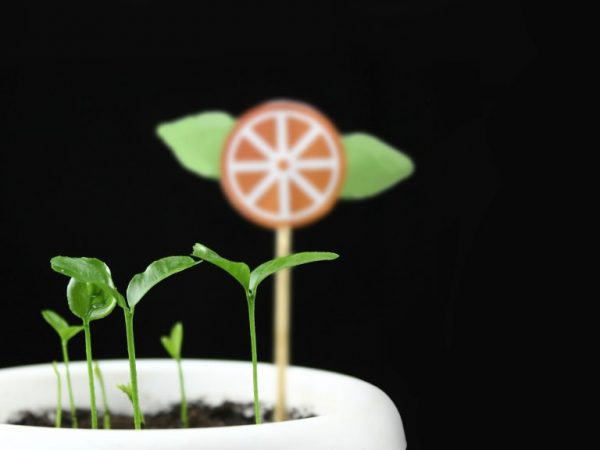

A tangerine grows soundly from a bone at home, only if you follow certain recommendations. When sprouting seeds in a pot, remember that they will need to be transplanted soon. But first, wait until four leaves are formed on each of the sprouts.
Then inspect all the shoots and select the largest ones for further cultivation.Then transplant the sprouts and continue to care for them. The next transplant will be needed when the root system of a young plant fills the entire flowerpot.
Conditions for planting and growing
In order for tangerine seeds to germinate, they need to create a comfortable environment. For growing tangerines, prepare a loose, neutral nutrient soil. You can buy a ready-made soil mixture with a pH in the range of 6.5-7. You can make it yourself by mixing:
- 1 part river washed sand;
- 2 pieces of leafy land;
- 2 parts of rotted humus.
Advice! Do not add peat to the potting mix. It is very loose but sour. In it, the tangerine will develop poorly and often get sick.
Disinfect the prepared soil by calcining it in the oven at a temperature of about 80 ° C for two hours. You can ignite it in a frying pan. Another way to rid the soil of harmful microorganisms is to water it with a dark solution of potassium permanganate. But then you have to wait for it to dry out.
For planting tangerines, prepare 200 ml seedling cups. They can also be planted in a common bowl about 8-10 cm deep. A mandatory requirement for a container is the presence of drainage holes to drain excess moisture.
Grafting
It is necessary to carry out the procedure under sterile conditions. During the procedure, due to inaccurate cuts, the stalk and tree may die. List of required inventory:
- sharp disinfected tool (knife);
- garden pitch;
- elastic tape.
Vaccinations are possible only on a healthy tree. The thickness of its barrel should not be less than 6 mm. The following procedure is recommended:
- Make an incision at a height of 10 cm in the form of a letter T. horizontally 1 cm, vertically - 2-4 cm.
- A scion without leaves and thorns is inserted into the incision. It must be taken from a branch at least 2 years old.
- The place of the cut is processed with garden varnish and fixed with tape.
- The graft is placed in a mini greenhouse: the pot is covered with foil and a humid atmosphere is created. It will stay there for a long time: up to a month.
Monthly scion, which has already grown well, is extracted from greenhouse conditions:
- The trunk is carefully cut obliquely. An incision is made 3 mm higher from the base of the shoot.
- The place of the cut is covered with garden pitch.
- A stick is placed in the pot to even out the growth of the tree.
According to the same scheme, grapefruit is grown from the seed. The formation of branches in this citrus is faster, so you need to know the nuances of its cultivation.
HOW TO GROW MANDARINE FROM STONE IN HOME CONDITIONS.
We suggest that you familiarize yourself with How to purify water at home without a filter
How to grow tangerines from seed at home (part 1)
How to grow a tangerine at home from a bone
Planting tangerine seeds
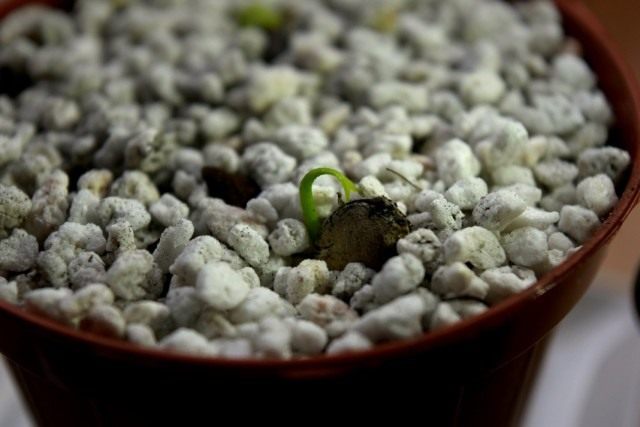

Planting mandarin seeds is as follows:
- Fill the seedling cups (or bowl) with loose and nutritious soil so that there is about 2 cm of free space to the top edge.
- Use a stick (or pencil) to make small indentations (about 2-2.5 cm).
- Place one mandarin seed in each cavity. If the seed has already sprouted, then it must be lowered by the sprout down, because this is the root.
- Water the soil liberally.
Cover the cups or a common dish with a plastic bag or glass to provide the seeds with high air humidity and stable heat. If you don't cover the planting, the seeds will still germinate, but this may take longer. Place the containers on a well-lit windowsill.
Soil selection
Let's figure out how to germinate a tangerine seed and how difficult it is. First of all, the preparatory steps are important, such as the selection of seeds or the preparation of the potting mix.Whether the indoor tangerine will bear fruit and develop fully depends largely on the quality of the soil.
If you do not want to spend money on purchased soil mixtures and are absolutely sure that you can prepare the necessary substrate yourself, the most optimal earth composition is a mixture of the following components:
- humus;
- forest land;
- sand.
Tangerine sprout care rules
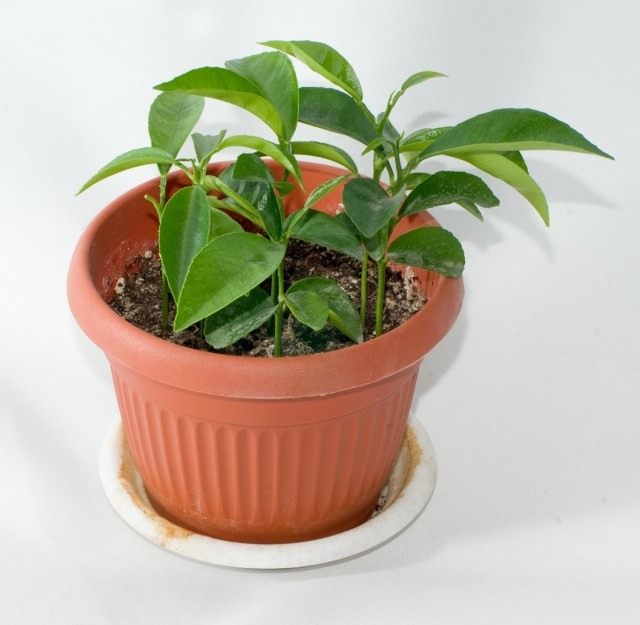

After 5-7 days after planting the tangerine seeds, you will see the first sprouts. They need special care to develop into strong trees. We will find out in what conditions the tangerine needs to be kept, and how to properly care for it.
Transfer
When the mandarin seeds sprout, remove the film (glass) from the container. Citrus plants develop very quickly. Therefore, after the cotyledon leaves, the first true leaf will soon grow. This means that the time has come to transplant the sprouts into new individual pots. They should be larger. For this, flower pots with a volume of 900-1000 ml are suitable.
Step-by-step instructions for transplanting sprouts into individual containers:
- Pour a drainage layer down the pot. It can be small pebbles, chipped bricks or foam torn into pieces.
- Then add some soil. It should be the same as the one you used to germinate the tangerine seeds.
- Water the tangerine sprouts liberally so that they can be easily removed from the soil along with the root.
- Take out the sprout, put it in a pot and, holding it with one hand, fill it with soil so that it is buried 1 cm above the level that it was before.
- Moisten the soil and sprinkle it with a small layer of dry soil so that after watering, a hard crust does not form on the surface.
In the future, the mandarin will need a transplant every year. The diameter of the pot should increase by 1-2 cm every year. An unscheduled transplant may be required. This happens when the soil is depleted so much that old leaves begin to fall off, and new ones grow small and frail.
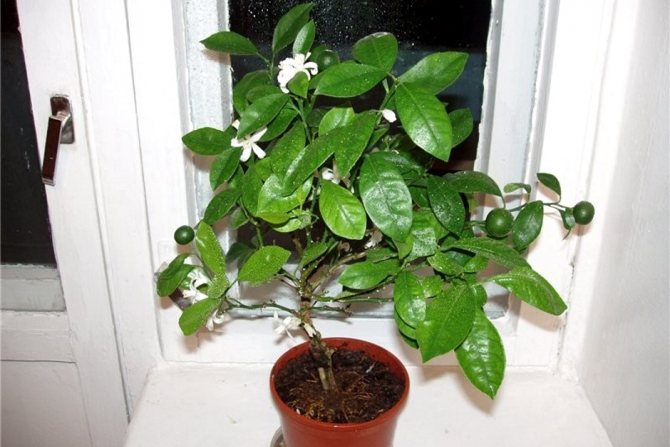

Advice! The best time to transplant is the beginning of the active growing season. Tangerine trees come out of hibernation in spring (March-April).
Top dressing and fertilizers
In the first year, tangerines do not need feeding, as they have enough of those nutrients that are contained in the soil. Starting from the second year of the growing season, the tree is fed every 2 weeks. To do this, you can use:
- Chicken droppings. It cannot be used in its pure form, so it must be diluted in water in a ratio of 1 to 20 and infused for several days. The resulting infusion must be diluted again in water in the same ratio before use.
- Infusion of mullein. This is the name of cow dung diluted in water in a ratio of 1 to 10.
- Complex fertilizer for citrus fruits. For example, Bona Forte or Zdraven.
If you have planned a transplant, then feeding should be stopped at least 3 days in advance. In winter, tangerines are not fertilized, since in the Russian climate at this time it is in a dormant period.
Watering
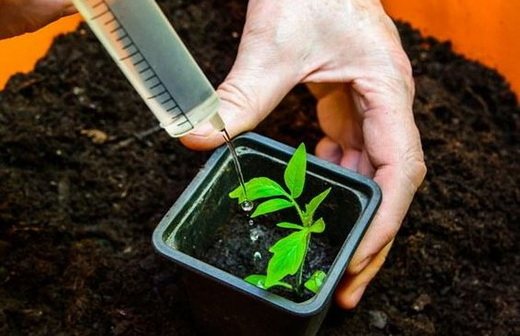

Water the tangerine tree as the soil dries out. Citrus plants do not like waterlogging of the soil. To find out if the clod is dry, tap the pot with your knuckles. If the echo is resonant, it's time to water, if it's deaf, there is still enough water. You need to pour so much water that it begins to seep through the drainage holes.
Mandarins love to be sprayed with water on their leaves. But you need to do this with water at room temperature that has been separated during the day. Citrus plants need to wipe the leaves if dust has settled on them.
Advice! During the rest period, keep the soil dry. So cut back on watering and stop spraying the leaves.
Temperature
In the early years, the temperature of the air at home is not so important for a young tangerine. The main thing is to keep it warm.But when the plant begins to bloom, good conditions must be created for it both for a dormant period and for a period of active growth.
In winter, the tangerine should be at a temperature of about + 10 ... + 12 ° C. In spring, the temperature should be increased to + 17 ° C to stimulate the formation of buds. To maintain flowering and fruit set in summer, it must be maintained at +25 ° C. But the heat must not be allowed, otherwise the flowers will disappear. Also, do not expose them to water.
Lighting and location
Mandarin loves a lot of light. But he must be absent-minded. Leaves can wilt in direct sunlight. Therefore, place the tree on a well-lit windowsill and create a light shade for it.
If there is no place in the home that is well lit by the sun, use artificial light. For additional illumination of tangerines, special phytolamps are needed, which emit the range of light waves that are necessary to maintain the processes of photosynthesis.
Air and humidity
Mandarins love moist air. Therefore, in winter, when the air in the apartments becomes especially dry, the tree suffers from a lack of moisture. It is advisable to use a special humidifier to humidify the air. An alternative method is to hang wet sheets indoors.
Citrus trees don't like drafts. Therefore, they do not need to be placed near an open window. For the same reason, you cannot take the plant out onto an open balcony. But if it is glazed, and it is warm enough, then the tangerine will feel good there.
Diseases and pests of mandarin seedlings
Mandarin can be settled by:
- flies;
- aphid;
- ticks.
It is not necessary to use insecticides to kill the pests of the tangerine tree. You can deal with them by washing the stems and leaves with running water and using soap. To prevent the reappearance of pests, put onion peels or garlic in a pot of tangerine. You can also periodically water it with infusion of garlic or onion peels.
With systematic waterlogging of the soil, tangerine is affected by fungi. First, a white bloom forms on the soil, then the aerial part of the plant begins to suffer. This happens when the roots have started to rot. In this case, a tree transplant and preventive treatment of its crown and roots with a fungicide solution is needed.
Care questions
How to achieve fruiting mandarin?
The use of a number of techniques will help speed up fruiting:
- Presowing seed treatment with stimulators of growth and fruit formation... The most popular: "Epin-extra", "Zircon", sodium humate, "Heteroauxin". These drugs help plants from an early age to adapt to dry air, lack of lighting.
- Selection of the strongest seedlings: no crooked shoots, with large leaves and a stocky crown.
- Balanced diet... Regular feeding with phosphorus-potassium fertilizers in combination with microelements stimulates fruit formation.
- Pinching the tops of excess shoots saves the plant's strength and helps to form a crown with short branches-fruits.
- Furrowing and banding - old techniques that allow you to redistribute the flow of nutrients to the crown and thereby accelerate the formation of fruit buds.
- Graft... Graft - a young tangerine stalk, cut in early spring, is combined with a seedling stock grown from the seed of any citrus. After 2-3 years, a single plant is formed, which begins to bloom and bear fruit.
How to plant a tangerine yourself?
To inoculate a tangerine, in addition to plant material, you will need a sharp knife and a strong elastic polyethylene tape 0.5 cm wide. Several inoculations can be done on one tree at once.
Common methods of vaccination:
- splitting... The rootstock is cut at a height of 5-10 cm from the root collar and split in the middle by 3-5 cm. On the lower part of the scion cutting, oblique wedge-shaped sections are made of the same length as the depth of the split.Then carefully insert this wedge into the stock. The junction is secured with a strapping.
- simple and improved copulation... Suitable for rootstock and scion of the same thickness. At their ends, oblique cuts are made and connected. Both parts should fit tightly when connected. The joints are tied with tape.
- budding... A cut bud from a varietal cutting is inserted under the incised rootstock bark and secured with tape.
Why do flowers fall?
- If the plant does not have enough strength and energy to germinate all the fruits, then it will itself regulate flowering and get rid of unnecessary ovaries.
- High indoor temperatures adversely affect flower formation. Due to the heat, flowers and ovaries fall off, or the flowering process is postponed to a later date.
- Tangerine can react to uneven watering by dropping flowers, for example, if the soil in a pot is dried out and then watered with plenty of water.
- Excess nitrogen in top dressing leads to increased growth of green mass, few flowers are formed and soon they begin to fall off.
Why do leaves turn yellow and fall?
One of the reasons is the lack of nitrogen and iron.
In the first case, yellowing starts from the lower leaves and spreads to the whole plant. With a nitrogen deficiency, tangerine is sprayed with a solution of urea or boric acid - 1 g per 1 liter of water.
With chlorosis, a disease caused by a lack of iron, at first the young leaves turn light yellow, then the old leaves also change color. For chlorosis, tangerine is sprayed with iron chelate once a month.
In addition to lack of nutrients, leaves can turn yellow and fall off due to:
- dry air in the room;
- drafts;
- exceeding the dose of fertilizers;
- change of place;
Leaf fall can be caused by natural causes - the beginning of the dormant time in the autumn-winter period.
How to grow a tangerine with fruits at home
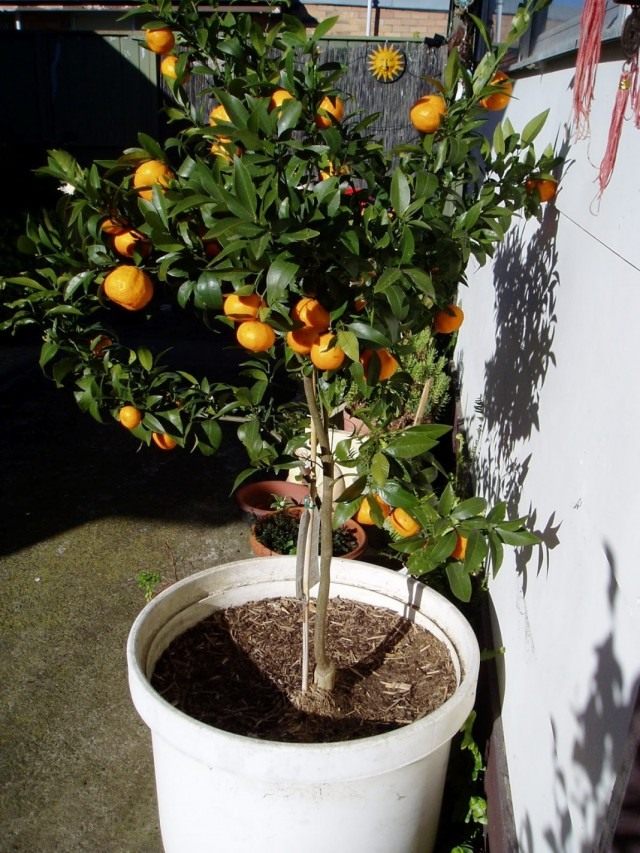

Growing a mandarin from a seed provides for late flowering. Usually, the first flowers in tangerines grown from seeds appear in the 9-10th year. But this time can be shortened. Let's find out what needs to be done for this.
Pruning
Flowers in citrus plants begin to appear on the shoots of the fourth order. But in the early years, the main shoot grows in the trees: it branches very poorly. In order for the tangerine to start delighting you with fruits faster, you need to cut it off. Pruning stimulates the growth of lateral shoots, improves the decorative qualities of the crown and speeds up the time of first flowering.
The main tangerine shoot is pinched when it reaches a height of 20 cm. For this, the apical bud is broken off with the help of tweezers treated with alcohol. After some time, side branches will begin to grow. They are also pinched when 3-4 leaves are formed on them. And this must be done with each new order. But thickening should not be allowed: for this, remove the branches growing inside the bush, as well as fattening shoots.
Important! Pruning a tangerine tree helps to achieve flowering as early as the 4th year after sprouting. However, there is no guarantee that the developing fruits will have the same decorative and taste qualities as tangerines from the store. Most likely, these will be small wild fruits with a sour taste. However, some may be lucky: according to the laws of genetics, 25% of tangerines grown from the bone will be just as large and tasty.
Vaccinations
Another way to speed up the appearance of the first fruits is to inoculate a mandarin. The procedure helps to get the first fruits as early as 2 years after it. You will need one branch of a varietal tree. You can borrow it from those who already grow this plant at home.
There are three options for grafting a tangerine tree:
- With a V-shaped cut made towards the center of the rootstock, into which the branch is inserted.
- With a T-shaped cut, into which a piece of wood with bark and bud is inserted.
- Acute angle inoculation. This option is suitable when the diameters of the rootstock and scion are the same. Places of cuts are connected.
The grafting procedure must be carried out quickly. The vaccination site must be tightly bandaged and treated with garden varnish. In order for the scion to take root better, the tangerine is watered with growth stimulants (for example, Epin) and covered with a transparent plastic bag to create comfortable conditions.
Attention! To grow a grafted mandarin, you don't have to grow a mandarin. You can use a lemon or other citrus tree. But it is believed that it is the wild lemon that has the strongest root system. Therefore, it is most often used for vaccination.
Have you bought a tangerine sapling?
Ready-made seedlings are grown in special greenhouse conditions. At home, this ideal environment is difficult to create. Therefore, you need to help the plant adapt: in advance, choose a suitable place in the house, create optimal humidity and air temperature.
When choosing a seedling preference should be given to young specimens in containers. The mandarin should have a small shoot with green leaves and healthy roots without damage. Also, be sure to check the seedling for the presence of pests.
At home, the purchased plant must be sprayed with any anti-stress drug.
It is better to buy a tangerine in early spring or summer, during this period it is easier for the plant to adapt to the new environment. He can spend the whole summer outdoors: on the balcony or in the country. Young tangerines should be protected from direct sun.
Features of growing mandarin
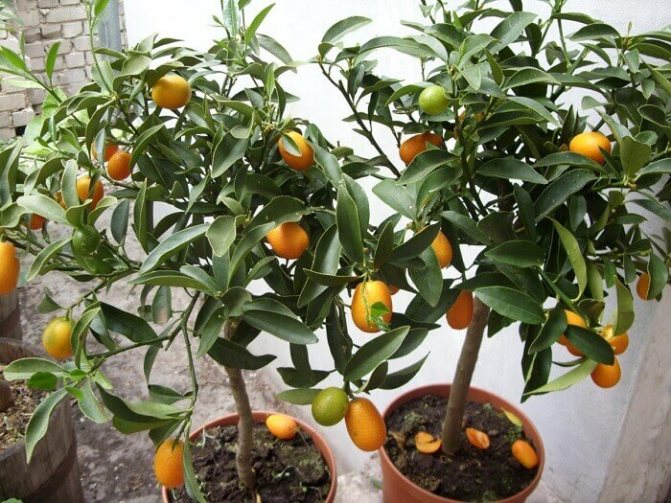

Those who first started growing a tangerine tree at home often face the following problems:
- The lower leaves dry at the ends and fall off. This happens with regular waterlogging of the soil. Repot the plant by removing the rotten roots and cut back on watering.
- The leaves began to turn yellow: first they turned yellow from below, then from above. This indicates that the soil is poor in nitrogen. Feed the plant with organic fertilizers: mullein or chicken droppings.
- The leaves turn yellow: young leaves are already formed yellow, and then the plant turns yellow in the lower part of the crown. This indicates a lack of iron. Iron vitriol will help fill its deficiency.
- Mandarin blossoms but does not form fruit. Chances are it's too hot in your house.
- Leaves began to fall off the tree. This can cause either too dry air or a lack of potassium. If you are sure that the air humidity in the apartment is normal, pour a potassium nitrate solution over the tree. If not, humidify the air.
- If the leaves become light and their size has increased, they do not have enough light. Place the pot in a different, lighter spot. If this is not possible, purchase an artificial light source.
Attention! In mature trees, leaves can fall from old age. If the plant develops well, does not get sick, regularly blooms and forms fruits, then this is normal.
Anyone can grow a tangerine from a bone. Despite the fact that this is an exotic plant growing in warm countries, similar conditions of detention can be recreated in every apartment. With proper care, a tangerine tree can grow up to 1.5 m in height and consistently delight you with fragrant and juicy fruits.
Pests and diseases
All citrus fruits are very fond of pests. They get on them from the street through open windows and doors, move from neighboring plants.
Spider mite
In dry air, the spider mite is the most sworn enemy. Its presence can be identified by a thin white web on the shoots and leaves.
At the beginning of the infection, spraying the plant with water will help. In advanced cases, chemical insecticides are indispensable.
Aphid
Small and prolific insect, yellow or green. Able to give more than 20 generations over the summer. Aphid larvae hibernate in the ground, on mandarin shoots.Adults live on leaves, buds, flowers, feeding on their juices.
In the initial stages, aphids can be completely washed off with a strong stream of hot shower. The water temperature should be between 50-60 ° C. Mass colonies are destroyed with insecticides.
Shield
It is more difficult to fight the scabbard - the waxy brown coating protects the pest. Scale larvae are almost invisible. Adult insects, similar to small turtles, are easy to see along the veins on the back of the leaves. They are inactive and stick tightly to the leaves. In case of severe infection, the leaves and stems are covered with sticky secretions, and the plant may die.
Washing off with plain water will not help in the fight. The best remedies for the scabbard are the preparations "Aktara" and "Actellik".
In addition to pests, dangerous diseases can interfere with the development and destroy the mandarin.
Anthracnose
This is a common fungal disease. It starts with the appearance of light spots on the leaves, then they turn brown. The disease spreads to branches, shoots, flowers. On fruits, dark spots form around the stalk.
Increased humidity provokes the development of the disease. Damaged parts should be cut off, healthy ones should be treated with fungicides.
For prevention, it is recommended to spray the tangerine with a 1% solution of Bordeaux liquid at the beginning of the season.
Read more about anthracnose here.
Late blight
This is a fungal disease. Brown oily spots appear on the trunk.
The affected areas must be cleaned and treated with fungicides. Read more about late blight here.
Pest control
Even if all the conditions for planting mandarin seeds are met, this does not protect the plant from the development of diseases or pest attacks, which in the end often lead to the death of a citrus pet. Most often, the tangerine tree is attacked by the following pests:
- aphid;
- spider mite;
- whitefly citrus;
- scabbard and others.
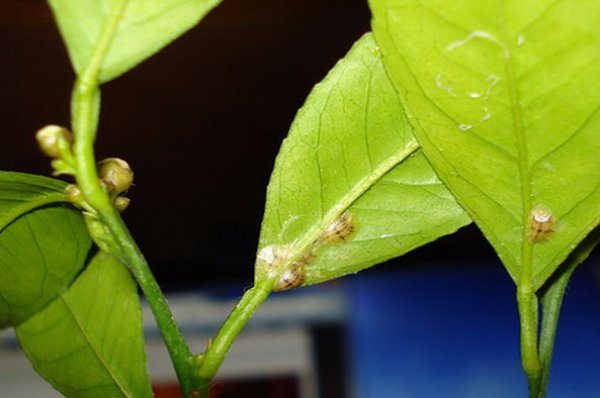

Mandarins infect several species of scale insects
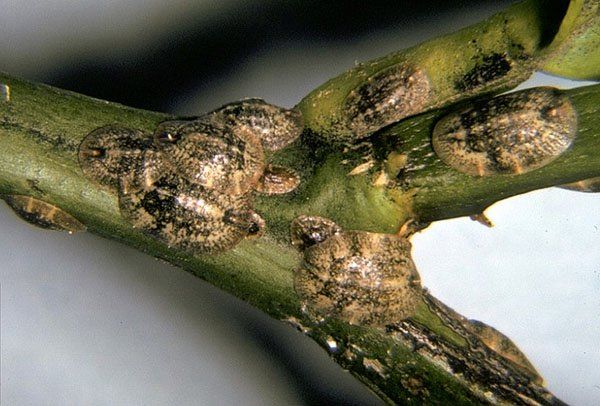

The scale insect causes irreparable harm to the plant
As a preventive measure, young plants must be inspected regularly to take action when the first suspicious signs are detected... But if they are identified, you need to immediately rinse the plant under warm water, treat it with "green soap". No less effective in the fight against various pests and diseases are "Actellik" and "Fitoverm".
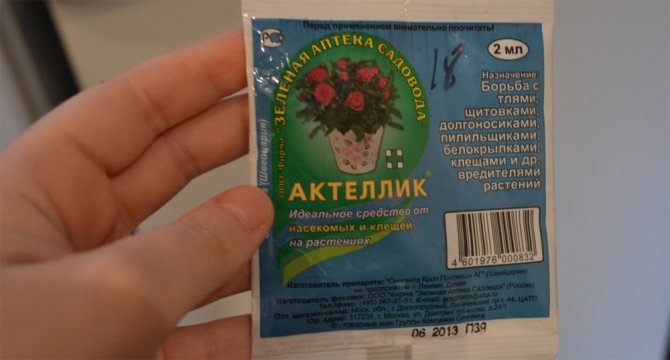

"Actellik"
Citrus products
Mandarins are considered low in calories, so they are often used in dietary meals. This fruit is used to prepare drinks, juices, classic compotes, lemonade. Isabella and chacha are made from it, alcohol and grapes. There are also recipes for compotes and pomace from dandelions, apples and plums with alcohol. There are many recipes that allow you to create a real dietary treat from healthy tangerine.
For example, crusts and candied fruits are delicious. To prepare them, you should soak the crust in water throughout the day. Then cut it into thin strips. Cook candied fruits in sugar syrup for an hour. Then they are laid out on a baking sheet and left to dry.
In the east, fresh slices of this fruit are added to sweet soups and vegetable salads. Ice cream is made from tangerine, milk, condensed milk, sour cream. The tangerine is peeled and mashed using a blender. Add condensed milk and sour cream. All mix and pour the mass into a container with a lid. Put in the freezer for 6 hours. Every 40 minutes, you need to take out the container and mix the ice cream. It is recommended to serve the dessert with fruit syrup.
Thus, if there is no garden plot, you can grow a tangerine at home. To do this, use undersized varieties. To get a beautiful and fruitful tree, it is important to provide the plant with certain conditions of maintenance and proper care. See also the article: Schisandra chinensis: growing and caring for a plant in the open field.
How to plant a seed
When the bone has swollen, the root has sprouted and sprouted, it is time to plant it at home. You do not know what a grown seed looks like, it is better to look at the photo so as not to make mistakes.
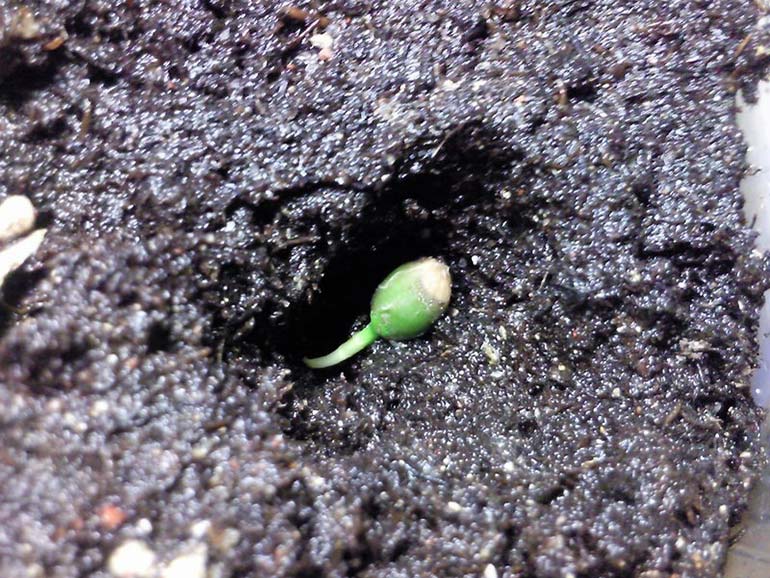

A small pot or flowerpot with a volume of more than four liters is suitable for planting. Before filling the ground, fill the drainage at the bottom. It can be small pebbles, nut shells, expanded clay, etc. Then we fill the flowerpot with earth, leaving about 6 cm from the top edge. We place seeds on the ground, preferably several pieces at once, and fill them with four more centimeters of earth.
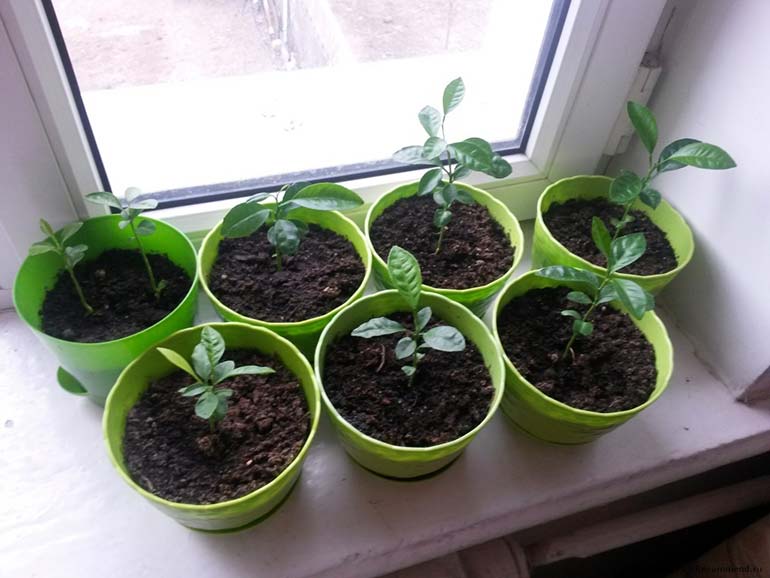

It is best to place the flowerpot with seeds in a warm place, ideally if from the south side and be sure to monitor the condition of the soil. The ground should be moist, but not wet. And the temperature is not lower than 20 ° C. Remember, you have a guest from warm, southern countries that requires special care.
What feeding to use
Small tangerines do not require feeding. Older plants are fertilized from the beginning of the growing season - in spring and until autumn. Once every two weeks, fertilizer for citrus fruits is applied in liquid form according to the instructions. There are other feeding options:
- Infusion of mullein in a ratio of 1:10 with water.
- Chicken manure solution 1:20.
- Fish broth for fruiting: boil 200 g of fish or its waste for half an hour in 2 liters of water, cool and strain. Spill the soil with liquid in the morning at + 17-20 ºC.
How to plant a bone
The seeds go 1-4 cm deep into the ground. Then water it, cover the container with glass or cellophane and put it in a warm, dark place. This will provide the necessary conditions for germination. As it dries, watering is repeated. After emergence, the container is moved to the windowsill.
Cellophane, glass should be removed immediately after the sprout appears, since the tangerine will quickly get used to humidity and will need to be taught to drier air.
This citrus comes from warm regions, so the optimal temperature for its development is in the range of 20-25 ° C. Growth stops at temperatures below 17 ° C.
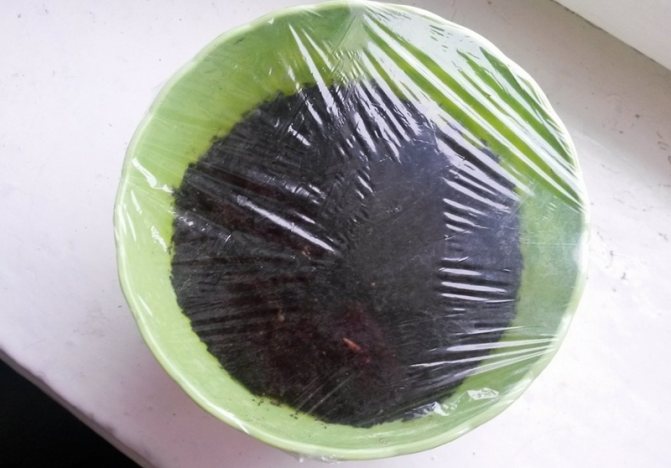

Stage two. Landing in the soil
Seeds that have already "hatched" must be planted in a seedling box or an ordinary pot. It is worth noting that some do not wait for the seeds to swell, but immediately start planting in the ground. Here sprouts are formed later, but outwardly they look no worse than those that grow from soaked seeds.
First, choose a suitable soil.
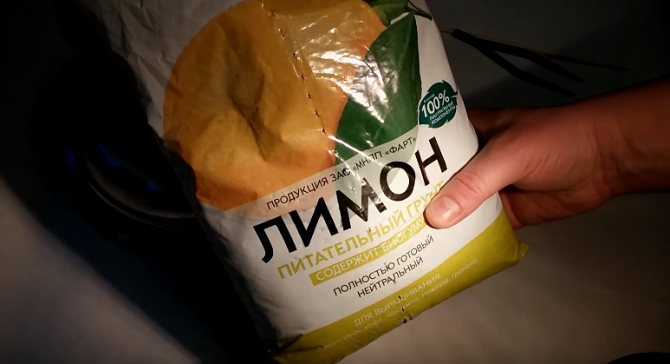

Soil for growing tangerine
Ideally, you should use a special citrus potting soil available from flower shops. Although what kind of soil will be used for growing does not play a special role. The difference between a homemade tangerine is, first of all, its unpretentiousness, so you can use almost any mixture - for example, from turf and leafy soil. It can also be a neutral nutrient soil ("Rose", "Biohumus", etc.). The main thing is not to use peat, because it quickly sour and dries up, and there are not enough nutrients in it.
You can also cook with your own hands soil mixture for growing home citrus crops - for this, mix the following ingredients in the indicated proportions:
- one piece of sand;
- three pieces of turf;
- one part of humus;
- one piece of leafy soil;
- some clay.
Fill the bottom of the prepared container drainage, as which you can use:
- small stones;
- fine-fraction expanded clay;
- brick fight.
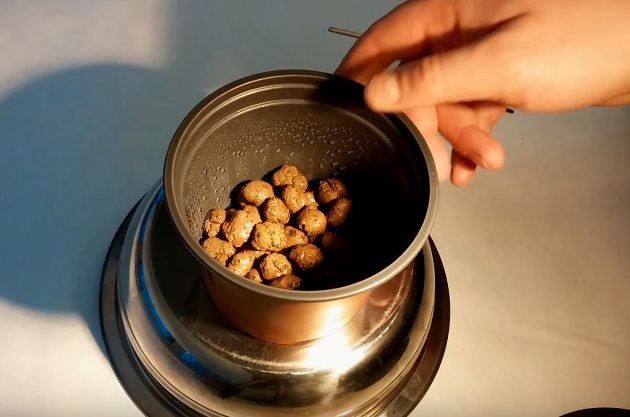

Pot drainage
Pour the prepared soil mixture on top of the drain, in which place the tangerine seeds. The first leaves should appear within three weeks after planting.
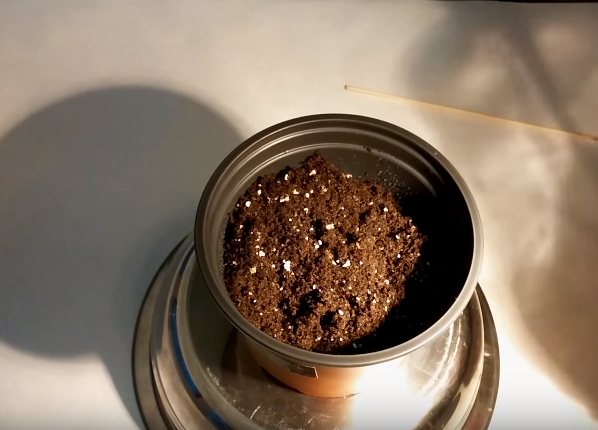

We fill up the soil in the container
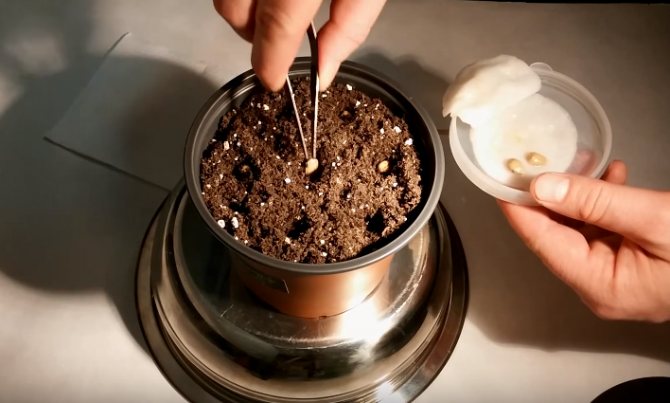

We plant swollen bones
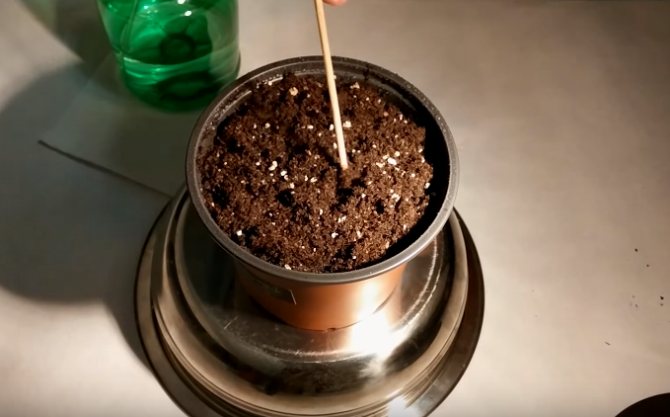

Add some soil
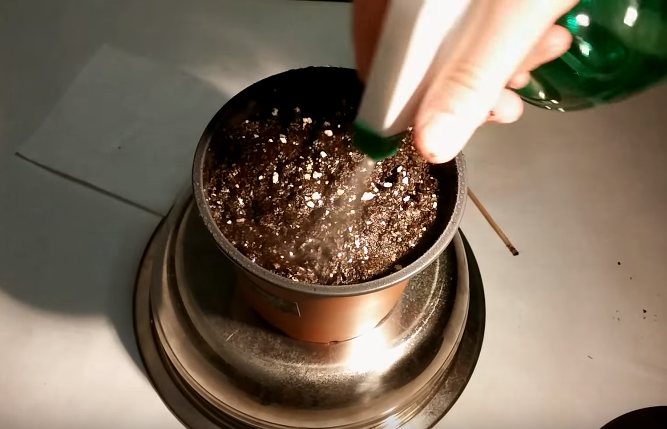

Watering from a spray bottle
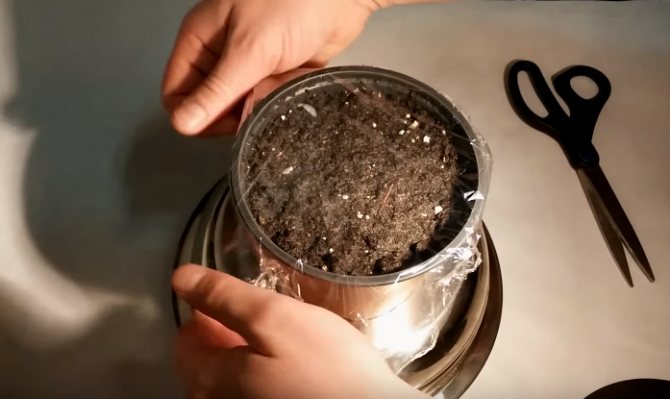

Cover the pot with foil
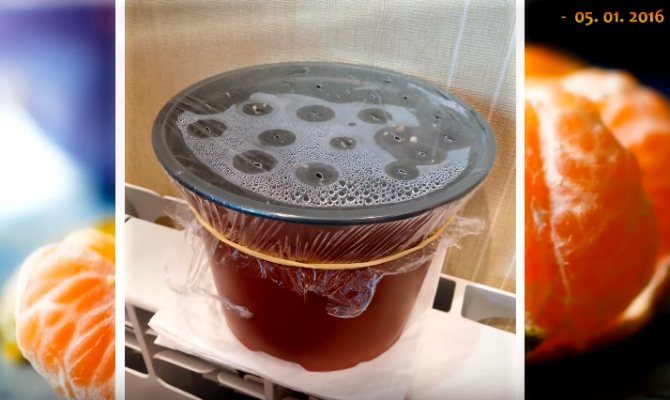

In the cold season, we put the pot on the radiator
Characteristics of homemade tangerine tree
Homemade tangerine belongs to the Rutaceae family.The plant is distinguished by its endurance and unpretentious care. Evergreen leaves are replaced every four years. Beautiful branches, shiny foliage and white flowers with a pleasant smell are not all that a home tree has to offer. With proper and patient care, tangerine will also delight you with fragrant fruits.
The plant propagates vegetatively or with the help of seeds. In home floriculture, a fruit tree is most often grown from seeds. But in most cases, beginners get a beautiful plant that is not able to form fruit. Everything is natural, because in a greenhouse, tangerines are forced to bear fruit by grafting, therefore, when growing at home, do not forget about this procedure.
Preparing the soil and pot
The soil for tangerine should not contain peat, because it does not retain moisture and oxidizes, which are detrimental factors for the seedling.
A neutral tangerine growing medium can be purchased at the store or prepared by yourself.
For this you will need:
- leafy soil - two parts;
- humus - two parts;
- sand is one piece.
Small expanded clay or pebbles are placed at the bottom of the pot, which will provide a drainage effect. A soil mixture is poured over the drainage. This base allows the roots to get enough air and moisture.
Crown formation
After the tangerines are grafted on the tree, it is necessary to adhere to some rules annually to properly form its crown. Moreover, this must be done only before the beginning of the first flowering of the plant. It is not recommended to allow the appearance of flowers until the branches of the 5th order are formed, otherwise the vegetation cycle of the plant will slow down.
If a tree grows with one shoot, then it must be cut so that 5-6 buds remain below, of which branches of the 1st order will grow further. Among them, those are left that are directed in different directions. After their regrowth, 4-5 buds are left on each branch, from which branches of the 2nd order will grow in the future.
Next, pruning is done, forming branches of the 3rd and 4th orders, after which the main skeleton of the plant is considered ready. The tree is suitable for flowering and fruiting.
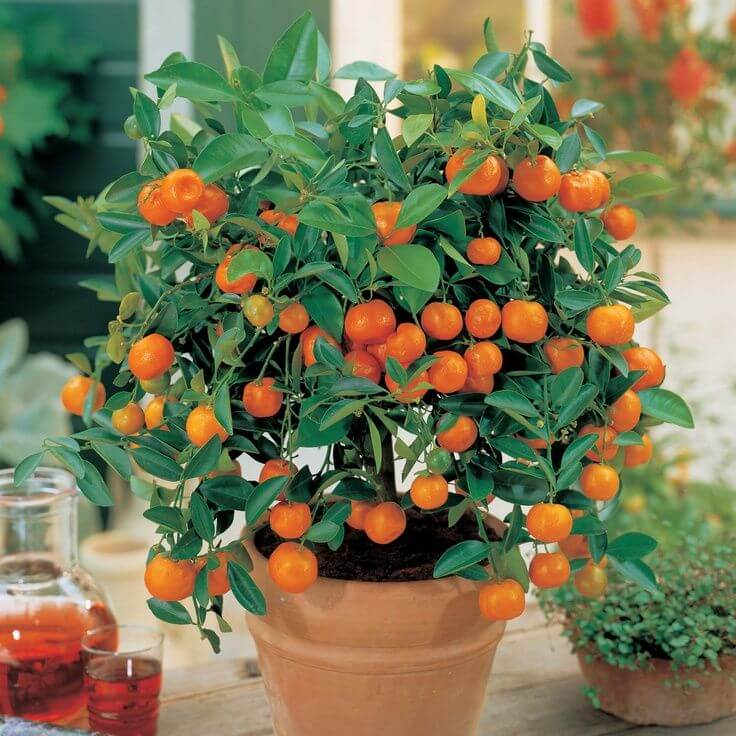

Leaving during flowering
In the flowering phase of mandarin, the need for potassium and phosphorus sharply increases. They strictly adhere to the irrigation regime, but do not oversaturate with water.
The tree needs frequent spraying, while trying not to get on the flowers in order to avoid burns.
When the mandarin begins to bloom, it is provided with a dormant period with less watering and kept at a temperature of + 10-12 ºC.
The plant itself regulates the load and sheds extra buds. If no fall occurs, the tree is helped by removing some of the flowers. It is considered the norm when there is one fruit for every 15-20 leaves.
How to prepare seeds for planting?
It doesn't take much work to grow a tangerine. You can do this exciting thing with your children. We assure them that they will really like it and soon you will have a whole botanical garden in your apartment.
First you need to prepare the ground. To do this, you need to purchase a package of soil in the store. But keep in mind that tangerine does not tolerate sour soil, which contains peat. Therefore, carefully read the composition on the package.
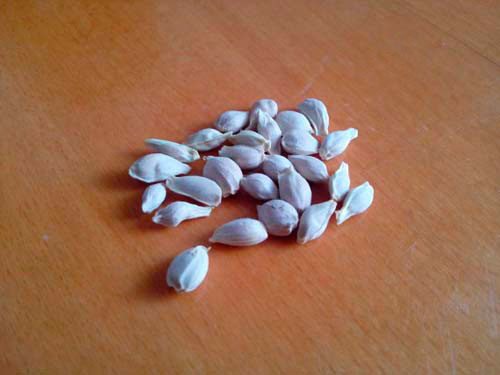

Next, you need to prepare our seeds for planting. In order for the seeds to germinate immediately, they need to be adjusted. To do this, wet a piece of cloth or cotton pad and put future tangerines on it. Make sure that the fabric is always damp, do not let it dry out, this is important. The seeds should be kept in moisture for at least two days.

